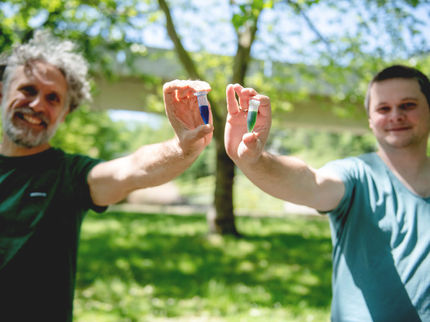Ancient rocks record first evidence for photosynthesis that made oxygen
A new study shows that iron-bearing rocks that formed at the ocean floor 3.2 billion years ago carry unmistakable evidence of oxygen. The only logical source for that oxygen is the earliest known example of photosynthesis by living organisms, say University of Wisconsin-Madison geoscientists.

Aaron Satkoski, a scientist in the UW-Madison Geoscience Department, holds a sample sawn from a 3.23-billion-year-old rock core sample found in South Africa. The bands show different types of sediment falling to the ocean floor and solidifying into rock. The sample provides the earliest known evidence for oxygenic photosynthesis.
David Tenenbaum/University of Wisconsin-Madison
"Rock from 3.4 billion years ago showed that the ocean contained basically no free oxygen," says Clark Johnson, professor of geoscience at UW-Madison and a member of the NASA Astrobiology Institute. "Recent work has shown a small rise in oxygen at 3 billion years. The rocks we studied are 3.23 billion years old, and quite well preserved, and we believe they show definite signs for oxygen in the oceans much earlier than previous discoveries."
The most reasonable candidate for liberating the oxygen found in the iron oxide is cyanobacteria, primitive photosynthetic organisms that lived in the ancient ocean. The earliest evidence for life now dates back 3.5 billion years, so oxygenic photosynthesis could have evolved relatively soon after life itself.
Until recently, the conventional wisdom in geology held that oxygen was rare until the "great oxygenation event," 2.4 to 2.2 billion years ago.
The rocks under study, called jasper, made of iron oxide and quartz, show regular striations caused by composition changes in the sediment that formed them. To detect oxygen, the UW-Madison scientists measured iron isotopes with a sophisticated mass spectrometer, hoping to determine how much oxygen was needed to form the iron oxides.
"Iron oxides contained in the fine-grained, deep sediment that formed below the level of wave disturbance formed in the water with very little oxygen," says first author Aaron Satkoski, an assistant scientist in the Geoscience Department. But the grainier rock that formed from shallow, wave-stirred sediment looks rusty, and contains iron oxide that required much more oxygen to form.
The visual evidence was supported by measurements of iron isotopes, Satkoski said.
The study was funded by NASA and published in Earth and Planetary Science Letters.
The samples, provided by University of Johannesburg collaborator Nicolas Beukes, were native to a geologically stable region in eastern South Africa.
Because the samples came from a single drill core, the scientists cannot prove that photosynthesis was widespread at the time, but once it evolved, it probably spread. "There was evolutionary pressure to develop oxygenic photosynthesis," says Johnson. "Once you make cellular machinery that is complicated enough to do that, your energy supply is inexhaustible. You only need sun, water and carbon dioxide to live."
Confirmation of the iron results came from studies of uranium and its decay products in the samples, says co-author Brian Beard, a senior scientist at UW-Madison. "Uranium is only soluble in the oxidized form, so the uranium in the sediment had to contain oxygen when the rock solidified."
Measurements of lead formed from the radioactive decay of uranium showed that the uranium entered the rock sample 3.2 billion years ago. "This was an independent check that the uranium wasn't added recently. It's as old as the rock; it's original material," Beard says.
"We are trying to define the age when oxygenic photosynthesis by bacteria started happening," he says. "Cyanobacteria could live in shallow water, doing photosynthesis, generating oxygen, but oxygen was not necessarily in the atmosphere or the deep ocean."





















































